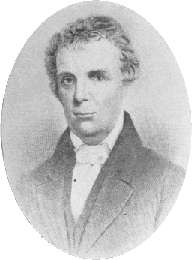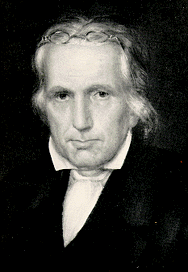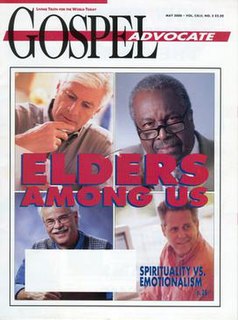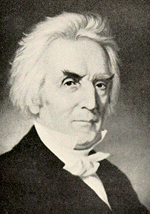
The Restoration Movement is a Christian movement that began on the United States frontier during the Second Great Awakening (1790–1840) of the early 19th century. The pioneers of this movement were seeking to reform the church from within and sought "the unification of all Christians in a single body patterned after the church of the New Testament."

Alexander Campbell was a Scots-Irish immigrant who became an ordained minister in the United States and joined his father Thomas Campbell as a leader of a reform effort that is historically known as the Restoration Movement, and by some as the "Stone-Campbell Movement." It resulted in the development of non-denominational Christian churches, which stressed reliance on scripture and few essentials. Campbell was influenced by similar efforts in Scotland, in particular, by James and Robert Haldane, who emphasized their interpretation of Christianity as found in the New Testament. In 1832, the group of reformers led by the Campbells merged with a similar movement that began under the leadership of Barton W. Stone in Kentucky. Their congregations identified as Disciples of Christ or Christian churches.
Churches of Christ are autonomous Christian congregations associated with one another through distinct beliefs and practices based on biblical examples. Represented in the United States and one of several branches across the world, they believe they follow biblical precedent for their doctrine and practices and only use examples from the early Christian church as described in the New Testament.

Barton Warren Stone was an American Evangelist during the early 19th-century Second Great Awakening in the United States. First ordained a Presbyterian minister, he and four other ministers of the Washington Presbytery resigned after arguments about doctrine and enforcement of policy by the Kentucky Synod. This was in 1803, after Stone had helped lead the mammoth Cane Ridge Revival, a several-day communion season attended by nearly 20,000 persons.

Thomas Campbell was a Presbyterian minister who became prominent during the Second Great Awakening of the United States. Born in County Down, he began a religious reform movement on the American frontier. He was joined in the work by his son, Alexander. Their movement, known as the "Disciples of Christ", merged in 1832 with the similar movement led by Barton W. Stone to form what is now described as the American Restoration Movement.

The Gospel Advocate is a religious magazine published monthly in Nashville, Tennessee for members of the Churches of Christ. The Advocate has enjoyed uninterrupted publication since 1866.
Batsell Barrett Baxter was an influential preacher and writer within the Churches of Christ.

Walter Scott was one of the four key early leaders in the Restoration Movement, along with Barton W. Stone, Thomas Campbell and Thomas' son Alexander Campbell. He was a successful evangelist and helped to stabilize the Campbell movement as it was separating from the Baptists.
Word and Work is a religious journal associated with those Churches of Christ that hold to a premillennial eschatology. It was founded in 1908 by Dr. David Lipscomb Watson.
The Christian Association of Washington was an organization established by Thomas Campbell in 1809 to promote Christian unity. It was a study group that Campbell formed with like minded friends and acquaintances in the local neighborhood of Washington, Pennsylvania. The group sought to foster unity by focusing on a common form of Christianity that they could all agree upon. This charter that Campbell wrote for this group, the Declaration and Address of the Christian Association of Washington, became one of the most important early texts of the Restoration Movement.
The Christians were a group arising during the Second Great Awakening of the early 19th century. The most prominent leader was Barton W. Stone. The group was committed to restoring primitive Christianity. It merged with the Disciples of Christ in 1832 to form what is now described as the American Restoration Movement
The Disciples of Christ were a group arising during the Second Great Awakening of the early 19th century. The most prominent leaders were Thomas and Alexander Campbell. The group was committed to restoring primitive Christianity. It merged with the Christians in 1832 to form what is now described as the American Restoration Movement.
The Christian Chronicle is a religious newspaper associated with the Churches of Christ. The Chronicle has a "news not views" editorial policy. A survey conducted in the early 1990s found that 68 percent of ministers in the Churches of Christ read the Chronicle, and 88 percent of those readers said they agreed with the content. The Encyclopedia of the Stone-Campbell Movement describes the Chronicle as "by far the most-read paper in the Churches of Christ and [it] exercises an influence for cohesiveness in this part of the Stone-Campbell Movement".
The Millennial Harbinger was a religious magazine established by the early Restoration Movement leader Alexander Campbell in 1830. Campbell viewed the magazine as an important vehicle for promoting the religious reforms that he believed would help usher in the millennium.

The Christian Baptist, established in 1823 by Alexander Campbell, was the first magazine associated with the early Restoration Movement. The prospectus for the Christian Baptist described its purpose as "[to] espouse the cause of no religious sect, excepting that ancient sect called 'Christians first at Antioch.' Its sole object shall be the eviction of truth, and the exposure of error in doctrine and practice." The style has been described as "lively" and "sarcastic". Campbell discontinued the Christian Baptist in 1830 and began publishing a new journal named the Millennial Harbinger which had a "milder tone".

The Living Oracles is a translation of the New Testament compiled and edited by the early Restoration Movement leader Alexander Campbell. Published in 1826, it was based on an 1818 combined edition of translations by George Campbell, James MacKnight and Philip Doddridge, and included edits and extensive notes by Campbell.
The American Christian Missionary Society (ACMS) was the first missionary organization associated with the Restoration Movement.
The Mahoning Baptist Association was an association of Baptist churches that was established in 1820 in Ohio's Mahoning Valley. Two prominent early Restoration Movement leaders, Alexander Campbell and Walter Scott, were closely affiliated with the Mahoning Association. The Association was dissolved in 1830.
The Christian Woman's Board of Missions (CWBM) was a missionary organization associated with the Restoration Movement. It was the first such group managed entirely by women. It hired both men and women, and supported both domestic and foreign missions.
The British Millennial Harbinger was a religious magazine established by the early Restoration Movement leader James Wallis in 1837. Wallis was a member of a group in Nottingham that withdrew from the Scotch Baptist church in 1836 to form a Church of Christ. It was originally named The Christian Messenger, then The Christian Messenger and Family Magazine. Wallis officially named the magazine The British Millennial Harbinger in 1848. His successor from 1861, David King, changed the name to the British Harbinger in 1866, then to the Ecclesiastical Observer 1871-1889.








